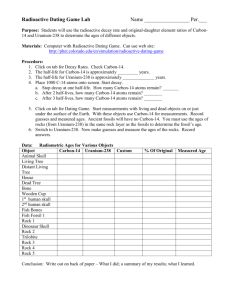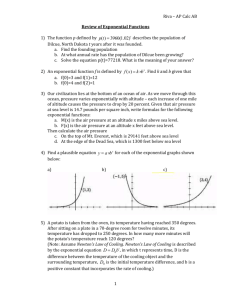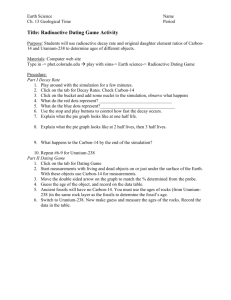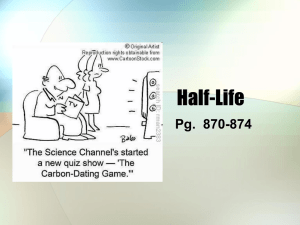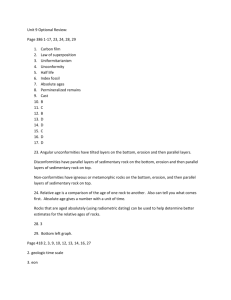USES OF RADIOACTIVITY - AGE OF ROCKS OR BONES
advertisement
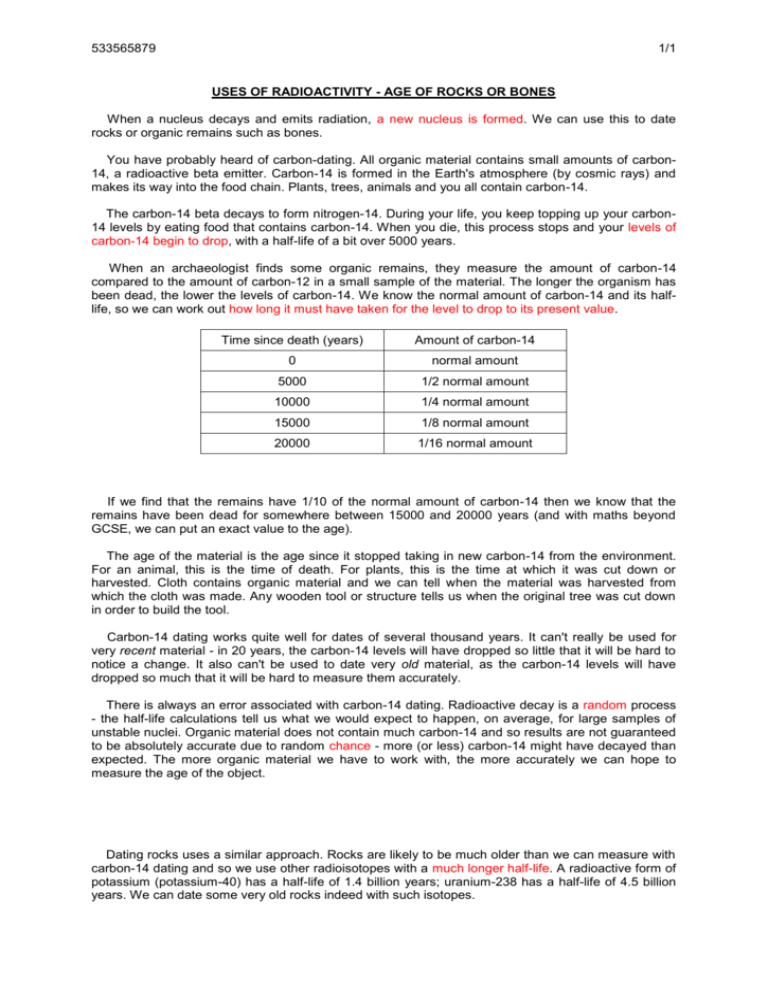
533565879 1/1 USES OF RADIOACTIVITY - AGE OF ROCKS OR BONES When a nucleus decays and emits radiation, a new nucleus is formed. We can use this to date rocks or organic remains such as bones. You have probably heard of carbon-dating. All organic material contains small amounts of carbon14, a radioactive beta emitter. Carbon-14 is formed in the Earth's atmosphere (by cosmic rays) and makes its way into the food chain. Plants, trees, animals and you all contain carbon-14. The carbon-14 beta decays to form nitrogen-14. During your life, you keep topping up your carbon14 levels by eating food that contains carbon-14. When you die, this process stops and your levels of carbon-14 begin to drop, with a half-life of a bit over 5000 years. When an archaeologist finds some organic remains, they measure the amount of carbon-14 compared to the amount of carbon-12 in a small sample of the material. The longer the organism has been dead, the lower the levels of carbon-14. We know the normal amount of carbon-14 and its halflife, so we can work out how long it must have taken for the level to drop to its present value. Time since death (years) Amount of carbon-14 0 normal amount 5000 1/2 normal amount 10000 1/4 normal amount 15000 1/8 normal amount 20000 1/16 normal amount If we find that the remains have 1/10 of the normal amount of carbon-14 then we know that the remains have been dead for somewhere between 15000 and 20000 years (and with maths beyond GCSE, we can put an exact value to the age). The age of the material is the age since it stopped taking in new carbon-14 from the environment. For an animal, this is the time of death. For plants, this is the time at which it was cut down or harvested. Cloth contains organic material and we can tell when the material was harvested from which the cloth was made. Any wooden tool or structure tells us when the original tree was cut down in order to build the tool. Carbon-14 dating works quite well for dates of several thousand years. It can't really be used for very recent material - in 20 years, the carbon-14 levels will have dropped so little that it will be hard to notice a change. It also can't be used to date very old material, as the carbon-14 levels will have dropped so much that it will be hard to measure them accurately. There is always an error associated with carbon-14 dating. Radioactive decay is a random process - the half-life calculations tell us what we would expect to happen, on average, for large samples of unstable nuclei. Organic material does not contain much carbon-14 and so results are not guaranteed to be absolutely accurate due to random chance - more (or less) carbon-14 might have decayed than expected. The more organic material we have to work with, the more accurately we can hope to measure the age of the object. Dating rocks uses a similar approach. Rocks are likely to be much older than we can measure with carbon-14 dating and so we use other radioisotopes with a much longer half-life. A radioactive form of potassium (potassium-40) has a half-life of 1.4 billion years; uranium-238 has a half-life of 4.5 billion years. We can date some very old rocks indeed with such isotopes.


